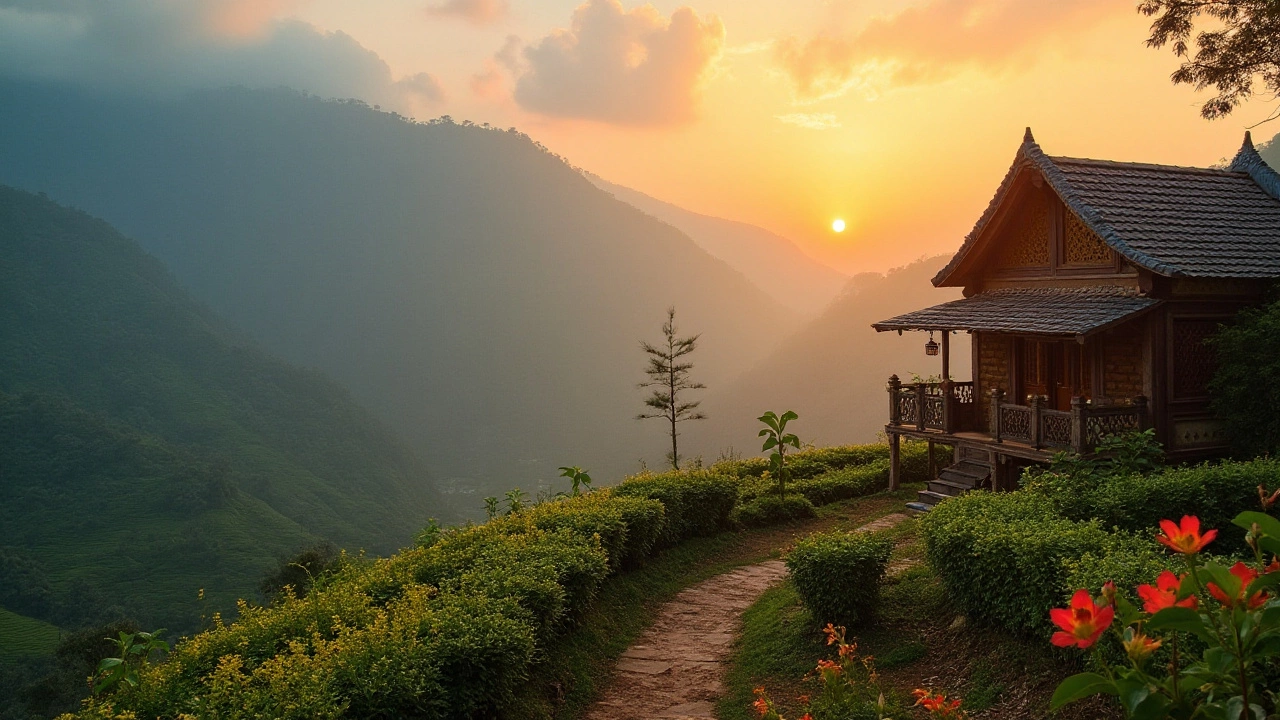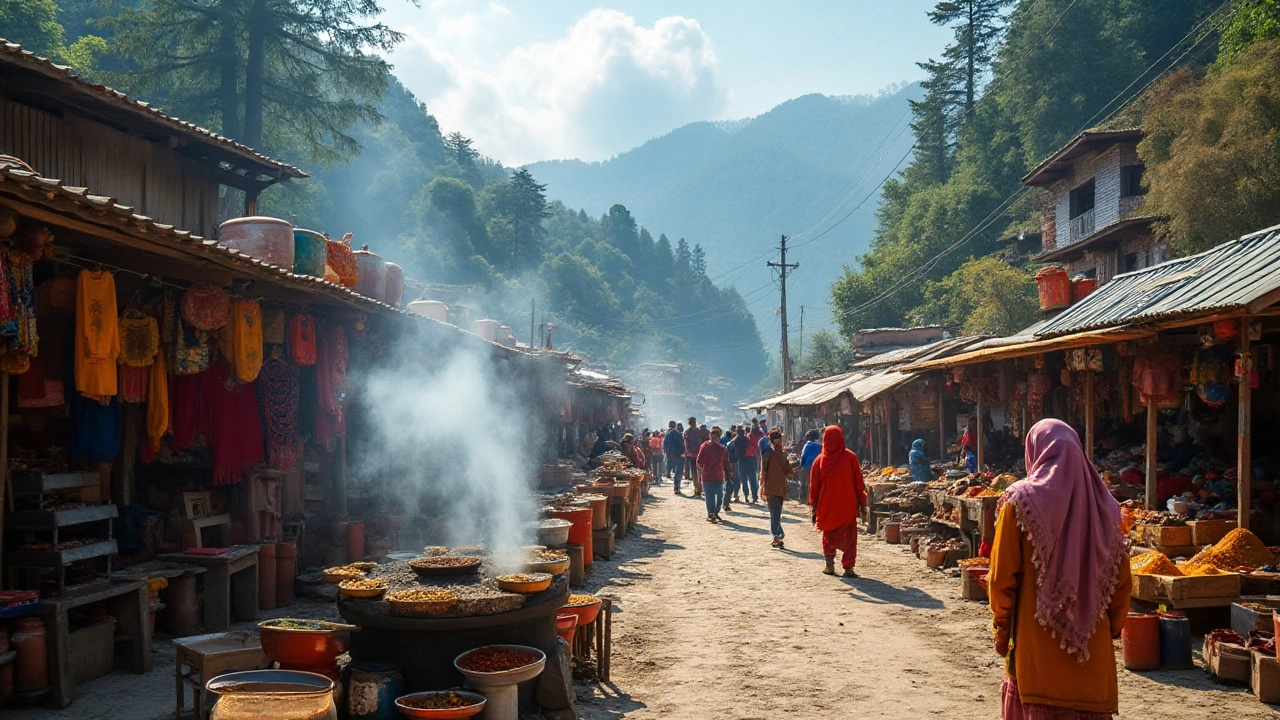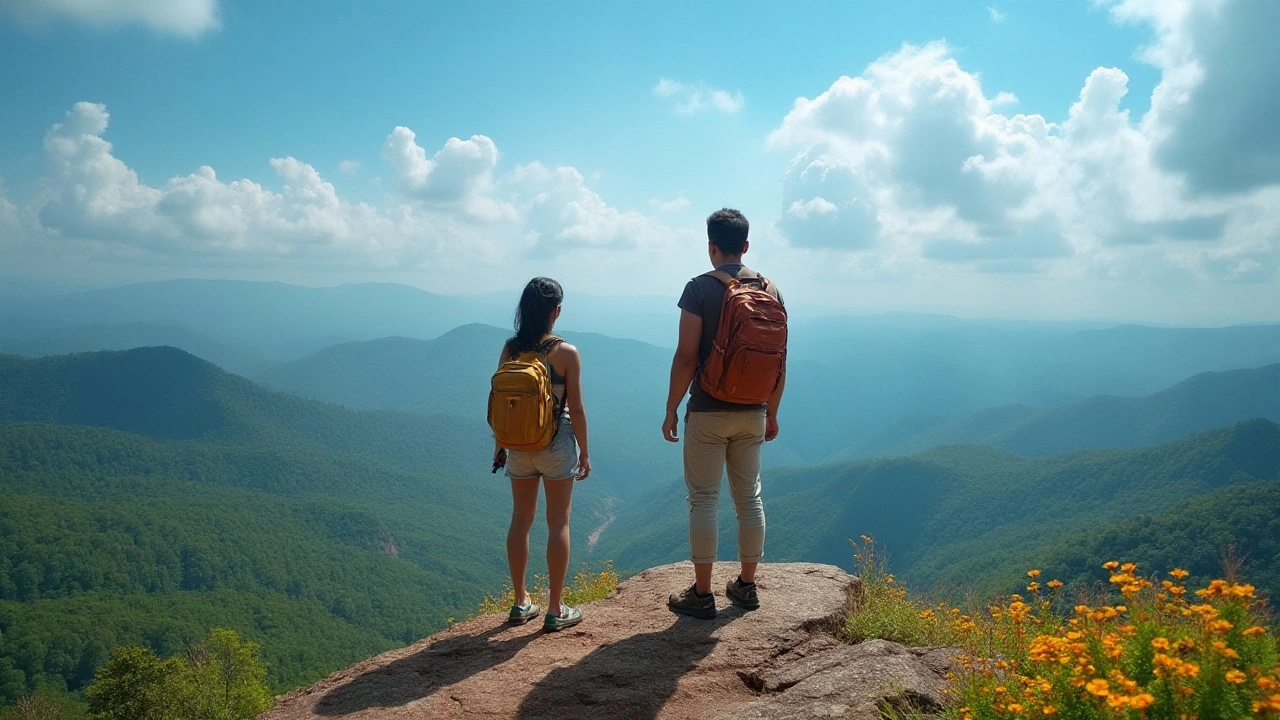Exploring the Most Stunning Hill Stations Worldwide: A Journey Through Nature's Beauty

- Jan, 29 2025
- 0 Comments
- Aaron Blackwood
When the hustle and bustle of city life wears you down, hill stations offer a much-needed escape into nature's embrace. These elevated gems, scattered across the globe, are prized for their crisp air, panoramic views, and serene environments. They serve as perfect getaways, painting a picture of peace that is hard to resist.
The allure of hill stations lies in their diverse landscapes and cultural experiences. Whether you find yourself walking through the lush green hills of Asia or strolling past the charming chalets of Europe, there is always something to captivate your senses. And it's not just about the scenery; each destination weaves a unique tapestry of history, culture, and tradition.
This exploration takes us to some of the most enchanting hill stations worldwide. We'll uncover what sets them apart and what they offer to travelers in search of beauty and tranquility. Arm yourself with practical tips and knowledge, whether you're a seasoned traveler or a curious newbie, ready to embark on a journey of discovery and relaxation.
- Defining a Hill Station
- Asia's Gemstone Hill Stations
- European Elevations of Elegance
- Hidden Treasures Across the Americas
- Essential Tips for Hill Station Travelers
Defining a Hill Station
Hill stations are more than just picturesque backdrops for holiday snapshots; they represent a unique blend of natural beauty and human history. The term 'hill station' typically refers to a town located at a higher elevation than the surrounding terrain, often shielded by mountains and embellished with lush landscapes. Historically, these areas offered a cool climate ideal for retreating colonists and native people alike, especially during the hot summer months. The ideal altitude for a hill station is typically between 1,000 and 2,500 meters above sea level, where the environment perfectly balances the allure of highland scenery with the comfort of habitable conditions. A fascinating tapestry of biodiversity thrives here, replete with flora and fauna uniquely suited to these montane environments. The concept isn't just about geography; it's about life slowing down to the rhythm of nature, a stark contrast to the relentless pace of urban living.
The popularity of hill stations rose primarily during the colonial era when European settlers sought refuge from the oppressive lowland heat. This history is particularly evident in regions like India, Africa, and Southeast Asia, where colonial powers established these elevated retreats. The architecture reflects this heritage, with many hill stations boasting charming colonial buildings, steeped in history and now often repurposed as hotels or museums. For instance, Shimla in India, once the summer capital of British India, stands testimony to this legacy. The infrastructure of these towns, designed to cater to the leisure and administrative needs of their former colonial inhabitants, now serve modern tourists looking for a blend of historical allure and natural splendor.
Today, hill stations continue to serve as havens for those needing an escape into nature. With their alluring landscapes, they provide an ideal location for a range of activities, from hiking and wildlife spotting to cultural exploration. The economy in these regions often thrives on tourism, with local crafts, cuisines, and festivals offering a rich tapestry of experiences to visitors. According to data from the World Travel & Tourism Council, the tourism sector in regions that host hill stations contributes significantly to local economies, providing jobs and promoting the sustainability of these delicate ecologies. The interaction between humans and nature creates a delicate balance, making responsible tourism more crucial than ever.
"A hill station is not just about the views or the weather, but an environment where the spirit finds peace," remarked John Greene, a renowned environmental writer whose works highlight the intricate bond between humanity and nature.
Each hill station is unique, with characteristics shaped by its geographical location, cultural history, and ecological features. While some might be known for their snow-peaked vistas and winter sports, others might offer misty mornings with tea plantations stretching as far as the eye can see. The biodiversity of each hill station also reflects its unique identity, shaped by its altitude and climate. This diversity is an invitation for travelers to not only witness beauty but to delve deep into the stories each landscape tells. For those willing to explore off the beaten path, hill stations can offer delightful surprises that remain etched in memory long after the journey ends.
Asia's Gemstone Hill Stations
Asia, a continent as vast and diverse as the stars in the night sky, cradles some of the most stunning hill stations in the world. These elevated retreats have long been cherished for their cool climates and stunning vistas that provide a much-needed balm to the chaos of everyday life. As one winds through the serpentine roads leading to these tranquil havens, it's easy to see why innumerable travelers have fallen under their spell, mesmerized by the interplay of nature's textures and colors.
One of the most celebrated of these beautiful hill stations is Ella, in Sri Lanka. Known for its endless green hills and the famous Nine Arch Bridge, Ella captures the imagination with its misty mornings and serene afternoons. Hikers and photographers are particularly drawn to Little Adam’s Peak, where trails lead through sprawling tea plantations, offering panoramic views of densely forested valleys and distant waterfalls. Here, the rhythm of life slows, inviting visitors to reflect, rejuvenate, and simply bask in the splendor of their surroundings.
Northward, nestled in the foothills of the Himalayas, lies Darjeeling, a name synonymous with aromatic tea and breathtaking scenery. This Indian hill station offers a blend of colonial charm and cultural diversity, with its vibrant markets and the iconic toy train that chugs along its slopes. There’s an otherworldly beauty in viewing the sunrise over the mighty Kanchenjunga peak, often referred to as the 'Queen of the Hills.' It's these moments that linger long in the memories of travelers, taking root like the robust tea bushes that thrive in its rich soil.
"In every walk with nature one receives far more than he seeks." – John Muir
Adding to the list of Asia’s treasures is the quaint town of Sapa in Vietnam. Perched amidst the verdant Hoàng Liên Son mountains, Sapa is renowned for its terraced rice paddies and vibrant ethnic communities. The Hmong, Dao, and Tay peoples, among others, offer a glimpse into their rich traditions and way of life, which is deeply intertwined with the landscape. Trekkers often find themselves meandering through villages, greeted by the warm smiles of local children playing among the fields and the intoxicating scent of freshly prepared pho wafting from humble kitchens.
| Hill Station | Country | Known For |
|---|---|---|
| Ella | Sri Lanka | Nine Arch Bridge, Tea Plantations |
| Darjeeling | India | Tea, Himalayan Views |
| Sapa | Vietnam | Rice Terraces, Ethnic Culture |
Beyond their scenic beauty, these hill stations are living museums of nature, culture, and history, offering richly woven tapestries spanning centuries. The experiences they offer are as diverse as the regions themselves, with each corner revealing a new facet of life to appreciate. Whether you find solace in quiet reflection or adventure in exploration, Asia's hill stations hold the promise of both, awaiting those ready to discover their many secrets.

European Elevations of Elegance
Europe, with its rich and storied landscape, offers a multitude of stunning hill stations that exude elegance and timeless beauty. These destinations are renowned for not only their picturesque views but also their architectural marvels and vibrant cultures. As you meander through Europe's hill stations, each location tells a story of the past and present, blending nature with history in a seamless, enchanting experience.
A prominent example is the Swiss resort town of St. Moritz, nestled in the heart of the Alps. Known for its breathtaking natural landscape and as a favorite spot for winter sports enthusiasts, St. Moritz offers both a playground for the adventurous and a retreat for those looking to relax. The town's reputation precedes it as a haven of upscale leisure, with luxurious hotels and renowned culinary establishments dotting the area. As one visitor said, "In St. Moritz, the air is crisp, the sky feels closer, and every day brings a new perspective on its ageless beauty."
"The town retains its heritage charm while pioneering modern hospitality," according to Europa Magazin, highlighting the delicate balance struck by the destination over the years.
Moving across the continent, the Italian region of Tuscany boasts the charming city of Cortona. Perched on a verdant hillside, Cortona offers panoramic views of the Val di Chiana and showcases a rich array of Etruscan history. Visitors can wander through ancient streets lined with Renaissance architecture and sample the region's famous wines and cuisines, making Cortona a feast for all senses. The community spirit of hill stations like Cortona encourages travelers to immerse themselves in local traditions, adding a distinctive personal touch to the journey.
If we head north, the Scottish Highlands present a rugged, mystical allure that captivates the imagination. Known for their dramatic landscapes, the Highlands are home to quaint towns such as Fort William. As the gateway to Ben Nevis, the UK's highest peak, Fort William attracts hikers and nature lovers eager to explore its lush surroundings. The serenity of the lochs and the myths associated with the barren moors convey a sense of otherworldly enchantment, promoting introspection and wonder.
Just as varied as their landscapes are the activities one can embark upon in these travel destinations. Whether it’s skiing in the Alps, indulging in a cultural festival in the Pyrenees, or savoring a quiet moment overlooking the Lake District's serene waters, European hill stations offer a medley of experiences. They serve as vital sanctuaries for those yearning to escape the mundane routine. With their harmonious blend of old-world charm and contemporary amenities, these hill stations promise exhilarating experiences wrapped in nature's gentle embrace.
Hidden Treasures Across the Americas
The Americas, sprawling from the icy reaches of Canada to the sun-drenched beaches of Chile, harbor some of the world's most captivating hill stations. These lesser-known destinations offer an unparalleled blend of both natural beauty and serenity, serving as sanctuaries for travelers eager to experience their unique charm. Take, for instance, the tranquil hills of the Blue Ridge Mountains in the United States. Nestled within the Appalachian chain, these vibrant hills stand lush and alive, a refuge for those yearning to leave the deafening buzz of city life behind.
While the Blue Ridge might be more familiar to some, the hidden gem of Boquete in Panama often surprises even the most seasoned travelers. Perched high among volcanic highlands, Boquete is renowned for its spectacular vistas, pleasantly cool climate, and flourishing coffee industry. The La Amistad International Park, a UNESCO World Heritage Site, sprawls nearby, boasting biodiversity that can enthrall nature enthusiasts for days on end. An awe-inspiring fusion of tropical and montane forests, the park houses rare species seldom seen elsewhere.
"Nature's masterpieces are often hidden treasures, inviting us to unravel their secrets," reflected renowned environmentalist John Muir, a statement that amplifies the allure of these fascinating hill stations.
Not far away, Ecuador's Quilotoa Loop offers an adventure unlike any other. The loop, an assortment of paths circling the caldera of an ancient volcano, grants travelers mesmerizing views of Quilotoa Lake at its center. Vibrantly green hills roll out from the lake in an endless quilt, presenting an ideal backdrop for trekking enthusiasts in search of seclusion and natural wonder. As you hike through the Andean tapestry, local indigenous communities warmly welcome intrigued visitors, sharing glimpses into their age-old practices and beliefs.
Heading further north, Canada cradles its own alpine oasis in the form of Jasper. Situated amidst the iconic Canadian Rockies, Jasper exists in symphony with the wild, where travelers can indulge in winter sports or summer hikes across sprawling trails. The town itself fosters a quaint charm, with residents known for their affable, laid-back demeanor. Beneath a sky that's often alight with brilliant colors, courtesy of the Northern Lights, visitors discover the magic that Jasper effortlessly renders. During peak seasons, the community hosts myriad festivals celebrating the unique cultural heritage of the region, drawing enthusiasts from far and wide.
A look at these places offers a glimpse into the diversity of hill stations that reside across the Americas. Each station, while distinct from the next, stands a testament to the relentless beauty found in nature's elevated sanctuaries. Those who dare to venture beyond the typical tourist trails are rewarded with experiences that become tales to be shared for a lifetime. The exploration through serene landscapes, cultural exchanges, and the gentle whispers of these hidden havens speak to the soul, embodying the true spirit of adventure.

Essential Tips for Hill Station Travelers
Traveling to hill stations offers a unique experience, bringing fresh air and stunning vistas that are quite different from everyday life. When planning your trip, consider a few key essentials to ensure a smooth journey. Packing is the first big task. The trick is to find the right balance between preparedness and practicality. Most hill stations boast cooler climates, so it’s wise to carry layers that you can add or remove based on the weather conditions. Lightweight woolens or thermals could be helpful, especially during cooler evenings. Don’t forget to pack comfortable footwear, as you’ll likely find yourself walking along hillsides and exploring trails.
Weather is an unpredictable companion in hill country, and rain showers can be frequent but fleeting. Keep a compact, quick-dry umbrella or a raincoat in your backpack to tackle sudden downpours. Prioritize packing sunscreen and sunglasses, too. Contrary to what many believe, UV rays are often strong in regions of higher altitudes, and without protection, you risk sunburn or eye irritation. Additionally, your skin may experience dryness, so include a good moisturizer in your kit to keep it hydrated.
Healthwise, consider altitude changes and potential motion sickness on winding roads. It’s always prudent to bring along basic medication, such as pain relievers and something for nausea. As you might pass by regions with different health standards, drinking bottled or purified water is recommended to avoid stomach issues. Locating local markets that sell fresh produce is ideal for healthy snacking, supporting local communities while keeping up your energy.
Travel destinations like hill stations captivate visitors with their adventures and calm retreats. If you’re an adventure enthusiast, renting equipment for activities like trekking or biking might excite you more than a quiet stroll. Despite the allure, always prioritize safety by ensuring your gear is in prime condition or joining guided tours where local knowledge is invaluable. Considerations around wildlife, too—learning which areas to avoid and understanding local wildlife can aid in a safe trip.
While technology keeps us connected, it's worth remembering that hill stations often offer a chance to unplug and reconnect with nature. Cell service may be patchy, providing a hiatus from constant notifications. This is the perfect opportunity to practice mindfulness, soaking up the views without distractions. To keep those at home in the loop, however, you might want to notify them about possible communication gaps. Bringing along a fully charged power bank will serve you well to capture the perfect vistas your surroundings offer.
Nature preservation should be at the forefront of every traveler’s mind. Hill stations are more than just destinations; they are homes to ecosystems and indigenous cultures. As you travel, consider your role in minimizing your carbon footprint. An easy way is by avoiding single-use plastics and being conscientious about waste disposal. Be mindful of the noise levels, respecting the tranquility that draws visitors from around the world.